The new millennium hadn’t been kind to The Living Seas pavilion.
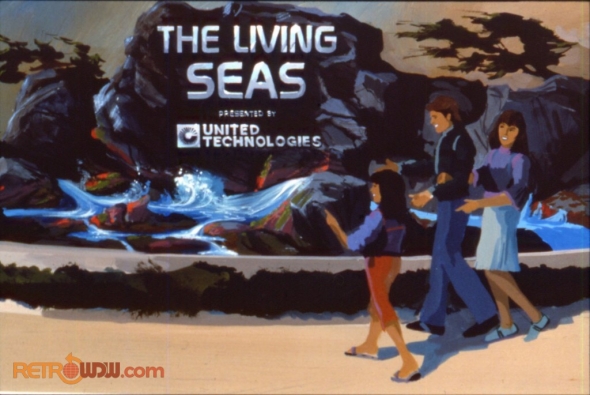
In June 1999, Epcot’s sponsorship woes struck yet again, and United Technologies was out. In 2001, Epcot decommissioned one of the two pre-show theaters leading into the attraction, essentially turning the vacant theater into a pass-through so that returning guests need not wait through the film showing and instead could proceed directly to the Hydrolators.
In October of that year, the “Caribbean Coral Reef Ride” in Omnimover “SeaCabs” was closed and boarded up so that guests exiting the Hydrolators would simply walk past the old attraction and proceed directly into the SeaBase.
By 2003, The Living Seas was far from a bright, vibrant, anchor attraction at Epcot. In fairness, Finding Nemo offered the chance to change that.
The Seas with Nemo and Friends
In December 2003 – six months after Finding Nemo’s stunning, record-breaking debut, the first wave of new changes came to Epcot’s The Living Seas in the form of simple scenic additions on the pavilion’s exterior to invite guests in (with, of course, new merchandise in the pavilion’s gift shop.)
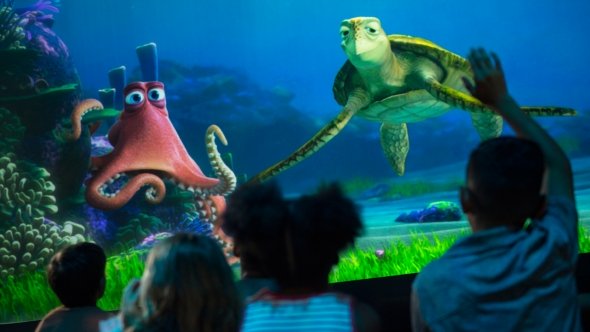
Then, the SeaBase’s Module 1C and 1D closed entirely. They re-opened in 2004 as Turtle Talk with Crush and Bruce’s Shark World playground. The former is an attraction in its own right (later exported to Disney California Adventure and Tokyo DisneySea) wherein guests are invited into an aquarium for a face-to-face encounter with Crush, the sea turtle from the film. Presented via live “digital puppetry,” Crush interacts with guests in real time, referring to them by name, asking and answering questions about the turtle world, and more.
Needless to say, Turtle Talk made a major impression on the Living Seas’ popularity. On August 21, 2005, The Living Seas pavilion closed to the public. Parts of the pavilion would re-open as available over the course of the next year, but behind ever-rotating construction walls, a rebirth was taking place.
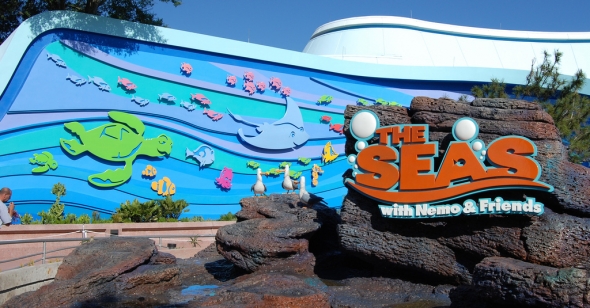
On October 19, 2005, Epcot’s oceanography pavilion re-opened, officially named The Seas with Nemo and Friends.
The beloved Hydrolators were sunk, replaced by an extended queue (leading guests from a beach to under a pier to underwater, so essentially doing the job of the Hydrolators without having to operate and maintain them… a budgetary win).
The third Hydrolator’s space was used to build out the pavilion’s existing Omnimover attraction. The simple Caribbean Reef Ride was extended with 280 feet of new track (nearly doubling the circuit), creating a more substantial, five minute “dark ride” with nine show scenes to usher guests into the attraction’s Seabase.
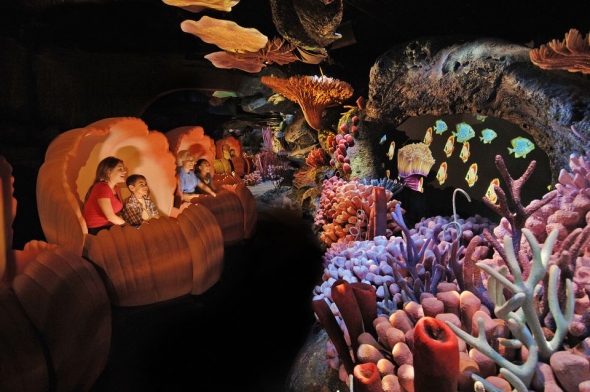
The high-capacity Omnimovers were rethemed from SeaCabs to Clamobiles, and cutting edge technology allowed the animated characters from Nemo to not just populate the reef around the ride, but to appear to swim with real fish in the ride’s finale. At the very least, Nemo and Friends’ expansion of the pavilion’s Omnimover into a more full-fledged dark ride is a welcome swap, even if it’s not quite the caliber of the dark ride originally planned for the Seas.
By 2007, Turtle Talk had become popular enough to move out of Module 1C and into the larger Module 1A, where some reconfigured walls allowed the old pre-show theater to become extended queue space for the popular Crush encounter.
Cartoon takeover
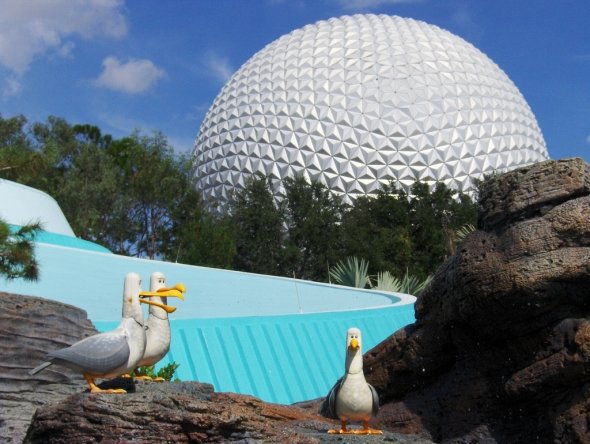
Though Nemo wasn’t the first Disney character to show up in Future World (that would be Timon, Pumbaa, and Simba in The Land’s retired “Circle of Life” film), the Seas with Nemo and Friends was certainly the biggest takeover of a pavilion we’ve seen yet (though Guardians of the Galaxy will top it).
As with any addition, subtraction, or change to Epcot, Nemo’s presence will probably be debated for the rest of time. For our part, we continue to rally for an “all-or-nothing” strategy for Future World.

After all, it was interconnectedness of EPCOT Center’s pavilions – their unification; how they could each look and feel so different, yet act as pieces of a larger puzzle – that was so thoughtful and spectacular back in 1982 and beyond.
So if Nemo is going to be in The Living Seas, why shouldn’t the Imagination pavilion be a trip through the creativity alongside The Muppets? TRON in Test Track? Big Hero 6 in Innoventions? Wall-e in Mission: SPACE? If a cartoon clownfish can represent the seas, why can’t Pocahontas reign over The Land? And for that matter, why couldn’t the Guardians of the Galaxy teach us about time? At least then, the pavilions would be reunited, with each having a “host” character threaded through the pavilion’s attractions while retaining their commitment to their areas of study.

Of course, much preferable to some Disney Parks fans would be just the opposite – the complete and unified removal of Disney characters from Epcot’s pavilions, replacing them with original stories, settings, and intellectual attractions. And couldn’t the Energy pavilion be a blacklight, LPS dark ride alongside original comic character “Energy Heroes” saving us from the powers of the notorious villain Blackout by exploring alternative energy sources? Couldn’t Imagination feature Dreamfinder and Figment again, as in the Lost Legend: Journey into Imagination? The Land pavilion have its attractions connected in message and narration by The Landkeeper?
Or, even after its multi-year transformation, will Epcot continue to offer ’80s aesthetics masked by ’90s and 2020s updates, brainless thrill rides, and educational origins overlaid with characters? Speaking of which…
SEABASE: Nemo?
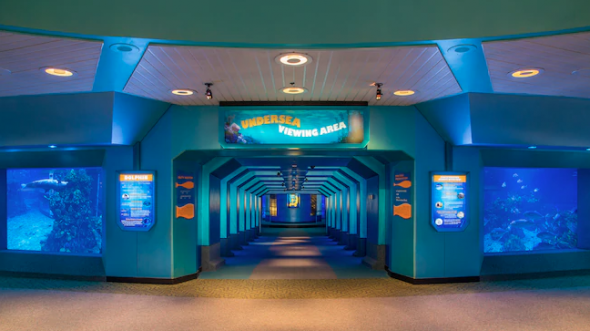
Ultimately, The Seas with Nemo and Friends did give new life to the Living Seas pavilion, albeit by weakening or removing some of the pavilion’s more signature elements, like its dramatic (and very EPCOT Center-style) pre-show, the memorable Hydrolators, and that famous Epcot sense of optimistic futurism.
In so doing, it also created an odd juxtaposition of style and substance. Despite Nemo’s fanciful, glowing characters, a new dark ride through a cartoon reef, and painting the pavilion’s interior in teals with orange accents, the bulk of the attraction is still a clearly-‘80s-designed industrial Sea Base…

…Not exactly the kind of locale you’d expect Nemo and friends to visit. It’s that same issue that some say plagues Epcot’s pavilions’ exteriors as well – no amount of paint can disguise the dated style of what ’80s designers expected the future to look like. And even if the Seas were properly redressed to replace the ‘80s sea base with Finding Dory’s more modern Marine Life Institute, it stands to reason that the billion-dollar-earning 2016 sequel is the tale of Dory’s escape from such an aquarium…
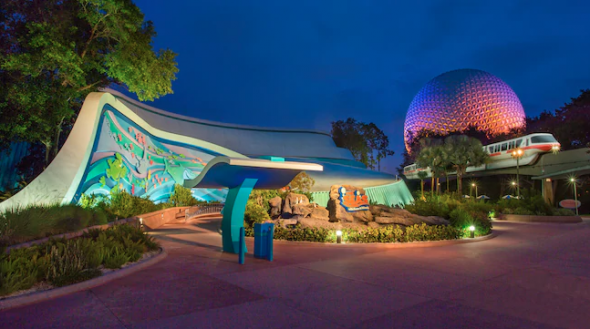
It’s interesting. The Living Seas was – in some ways – Disney’s answer to SeaWorld. And yet, it hasn’t earned one one-hundredth of the controversy. Perhaps it’s for the best. After all, Nemo or not, Epcot’s Seas pavilion remains one of the closet we can find to the original spirit of Epcot: to entertain, inform, inspire and above all, instill a new sense of belief and pride in man’s ability to shape a world that offers hope to people everywhere.

Thank you so much for reading. Now, it’s your turn to join the story. If you enjoy spending time falling down the “rabbit hole” of Park Lore’s in-depth, ad-free, member-supported stories, consider becoming a Member for as little as $2 / month.
Members can unlock rare concept art in every tale, reveal attraction audio streams in select stories, gain access to over a hundred exclusive articles in our quick-read Extra Features and in-depth Special Features collections, gain exclusive podcast extras, and receive an annual member card and merch in the mail! (Plus, y’know, supporting research-based, ad-free, clickbait-free, in-depth theme park writing!)
In the mood for another story? Make the jump to our Lost Legends to set course for another closed classic attraction, or to explore the in-depth histories of Disney’s best (and worst) attractions from around the globe. Or, make a quick connection to another of Epcot’s Lost Legends: Kitchen Kabaret, Soarin’, Journey into Imagination, Captain EO, World of Motion, TEST TRACK, Body Wars, Universe of Energy, Horizons, and Maelstrom.


